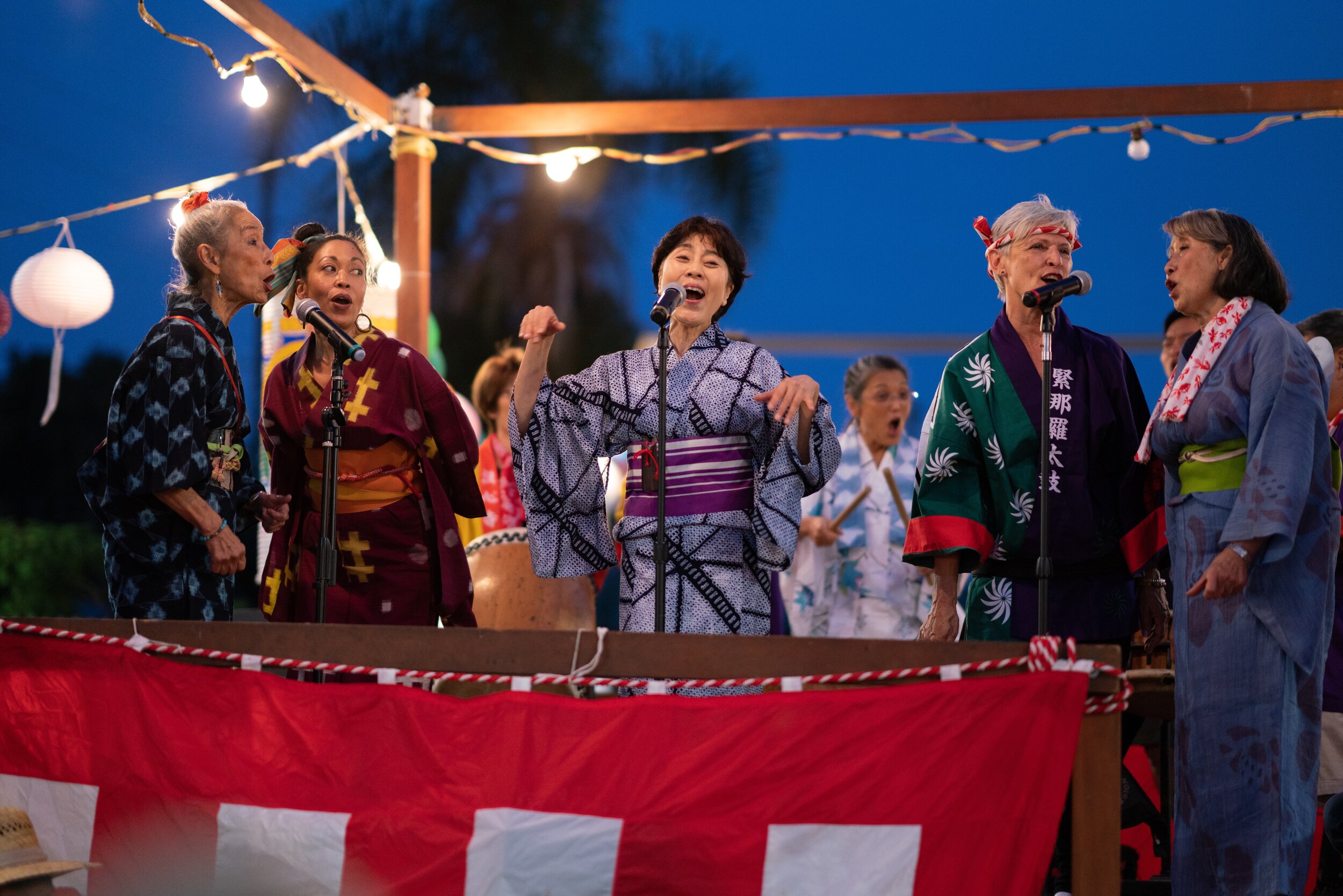Ei Ja Nai Ka
ISN’T IT GOOD?
“Ei Ja Nai Ka is dance, rhythm, song, and chant in celebration and commemoration of our immigrant ancestors with endless gratitude. ”
Beginnings
Early 1970’s
PJ was forever changed in body, mind, and spirit when she danced to “Tanko Bushi Rock” by Chris Iijima and JoAnne Nobuko Miyamoto in a wild and spontaneous display of unabashed joy. This inspirational moment is what moved PJ to create Ei Ja Nai Ka.
PJ danced Awa Odori (Baka Odori, the Fool’s Dance) in Tokushima, Shikoku, Japan in 1972. She was mesmerized by the energy of the dance and seamless fusion of dancers and audience, dancing in unity together.
At the Kokura Gion Matsuri, Fukuoka, Japan, PJ witnessed community players step and dance for hours as they played taiko drums on carts being pulled throughout the town. This procession later inspired the Ei Ja Nai Ka procession popularized by San Jose Taiko performing ensemble.
“Inside of me, what ignited was the community impact created by the circle of people raucously dancing. I felt this viscerally in my bones, a feeling that sank deep into my cells which I still feel today. Everyone was connected in pure joy. One heart, one dance.”
— PJ HIRABAYASHI
“Tanko Bushi Rock”, Nobuko Miyamoto (photo: Visual Communications)
Timeline
1970’s
PJ dances to Tanko Bushi Rock which literally rocked her world and inspired Ei Ja Nai Ka
1994-6
Taiko drum rhythm patterns were created, followed by the dance choreography
1997
Ei Ja Nai Kai became an open source song for the taiko community, announced by PJ Hirabayashi at the first North American Taiko Conference, Tyler Moriguchi inaugurates a tradition of dancing EJNK to cap NATC
2001
Yoko Fujimoto, veteran member of Kodo, writes the music and lyrics to EJNK in collaboration with PJ Hirabayashi and Nobuko Miyamoto for the “Triangle Project”
2004
Ei Ja Nai Ka breaks tradition and is officially added to the repertoire of the San Jose Buddhist Temple’s Obon Odori as the first taiko-based song
Ei Ja Nai Ka performed for the first time in Winnipeg, Canada at Hinode Taiko’s 20th Anniversary
2010
San Jose Taiko performs Ei Ja Nai Ka with Kagemusha Taiko, UK Taiko Festival theatre show
2013
Ei Ja Nai Ka performed for the first time at the UK Taiko Festival with community inclusion
2014
Ei Ja Nai Ka performed in Palestine at Bet Lahem Live Festival with Taiko Journey
2015
Ei Ja Nai Ka danced at 15 Southern California Buddhist Churches of America Temples
2019
Ei Ja Nai Ka performed for the first time at the European Taiko Conference
Ei Ja Nai Ka performed at the North American Taiko Conference for the 10th consecutive year
Ei Ja Nai Ka danced at San Jose Buddhist Temple’s Obon Odori for the 15th consecutive year
Ei Ja Nai Ka performed at Cortez Obon Centennial
2020
Ei Ja Nai Ka at Tsuru for Solidarity
2021
25th anniversary year of Ei Ja Nai Ka
Ei Ja Nai Ka Telling Our Stories Workshops led by PJ Hirabayashi, separate events hosted by Creatives for Compassionate Communities, Stanford University
2022
Ei Ja Nai Ka Telling Our Stories Workshops led by PJ Hirabayashi at Stanford University, part of Experiential Workshops, S. Shigematsu lecturer
The Dance
Ei Ja Nai Ka celebrates our Japanese American history. The dance movements commemorate the hard work and perseverance of the Issei, who were the first generation of immigrants from Japan.
READY TO DANCE?
Take the online video course instructed by PJ Hirabayashi and learn the Ei Ja Nai Ka dance movements, chant, melody, and more (subscription to kaDON required).
Dig Dig, Pick Pick
Resilient hands worked tirelessly in farms, railroads, and mines creating sustenance and hope.
Gather, Gather, Gather
Bundling the abundant fruits of our labor from sea to soil with diligence and determination.
Sweat, Sweat
And lots of it! Inspiration came from perspiration upon building a new life in America and enduring the challenges of discrimination.
Big Wheel
Steering the economy of the nation with essential work like grandpa’s “engine wiper” job with the Southern Pacific Railroad.
Toss the Net
Fishermen whose lives are tied together in spirit and survival envision a bountiful harvest of fish as they collectively cast their fishing net into the sea of dreams.
The Song
“I sang surrounded by 1,000 people in a circle of so much joy and it really filled me with strength.”
In 2001, PJ asked Yoko Fujimoto, friend and veteran member of Kodo, world-renown taiko group from Sado Japan, to write the music and lyrics to EJNK. Yoko worked with PJ and Nobuko Miyamoto during their “Triangle Project” collaboration to finish the piece. The words and music reflect the spirit of the ancestors who came before us—a song of global resonance and significance.
+ Lyrics
- Haa, yume wo kakaete. Haa, aranami koeta
A sora, ei ja nai ka, ei ja nai ka, Grandpa, ei ja nai ka
Ei ja nai ka, ei ja nai ka, Grandma, ei ja nai ka
Asemizu tarashite, honemi wo oshimazu
Ushiro sugata de oshiete kureta, nihon no kokoro
Holding onto a dream, riding over rough waves
Grandpa and Grandma
Sweat dripping, working without sparing yourself
Watching your back, I learned the spirit of
The Japanese heart
- Haa, asamo hayo kara. Haa, kibako wo katsugi
A sora, ei ja nai ka, ei ja nai ka, ichigo tsumi, ei ja nai ka Ei ja nai ka, ei ja nai ka, hito hako nan sento
Makka na minori ni teyubi mo somaru
Senaka nobaseba yuhi ga akaku nakama wo someru
Carrying your wooden box from early morning
Picking strawberries. One box, how much?
The red harvest dyes our fingers
The red sunset dyes our stretched backs
- Haa, kemuri hakidashi. Haa, unari wo agete
A sora, ei ja nai ka, ei ja nai ka, railroad, ei ja nai ka Ei ja nai ka, ei ja nai ka, steam engine, ei ja nai ka
Nishi kara higashi e nobiyuku senro ni
Kyo wo tsumikomi hakonde yukuyo ashita e mukatte
Smoke puffs and roars
Railroad and steam engine
The railroad expands from west to east,
Carrying today’s load toward tomorrow
- Haa, taiko tatakeba. Ha, ukitatsu kokoro
A sora, ei ja nai ka, ei ja nai ka, don don, ei ja nai ka Ei ja nai ka, ei ja nai ka, teretsuku ten ten, ei ja nai ka
Odoru ahou to iware tatte, ei ja nai ka
Kore ga yameraryoka yameraremashyoka
Odoro yo utao yo…Isshoni ni yuko yo
Hearts are cheered with the sound of the taiko:
Don don teretsuku ten ten
Even if we are called dancing fools, it’s fine
How can we stop? How can we ever stop?
Let’s dance. Let’s sing… Together, let’s go.
Call & Response
Ei Ja Nai Ka’s chanting amplifies energy when everyone is dancing, singing, and playing taiko drums. Through call-and-response, the chant connects people with lively interaction:
Ei Ja Nai Ka, Hai A so-re, A so-re
Ei Ja Nai Ka, Hai A so-re, so-re Yoi Sho
Ei Ja Nai Ka, Hai A so-re, A so-re
Ei Ja Nai Ka, Hai A so-re, so-re Yoi Sho
Ei Ei Ja Ja Nai Nai Ka Ka
Yoooooooooo Hai

An anthem for North American taiko
Ei Ja Nai Ka has become the beloved anthem of North American taiko celebrating the heart and spirit of taiko drumming. It’s popularity spans the taiko community at large as well as fans of taiko drumming who attend the many Japanese obon festivals and taiko performances around the country. It’s been danced with much joy and perspiration at the North American Taiko Conferences over the years. Ei Ja Nai Ka has been part of San Jose Taiko’s standard repertoire since it was first composed back in the mid-1990’s by then-Artistic Director of San Jose Taiko, PJ Hirabayashi.
The Spirit of Obon
The spontaneous street energy of Ei Ja Nai Ka encapsulates the spirit and soul of Buddhist Obon Odori dance festivals across America. Thanks to Reiko Iwanaga, San Jose Obon Head Dancer and Choreographer, Ei Ja Nai Ka made its debut at the San Jose Buddhist Temple Obon Odori in 2004, the first Obon to include a taiko-based dance within the set of traditional songs danced by the community. From there, the momentum of Ei Ja Nai Ka grew quickly with a permanent place in the repertoire of temples across California and around the country.
25th Anniversary Celebration
The year 2021 marks the 25-year anniversary of Ei Ja Nai Ka with a summer of community celebrations, well wishes, and happy remembrances. So much gratitude abounds for a song that sparks joy for all.
Ripples of Ei Ja Nai Ka
Around the World
“We love this dance because it expresses belonging to our motherland.”
“Ei Ja Nai Ka is your past. It is our future, our present.”
“If you dance, you are a fool. If you only watch the dance, you are a fool. So, you might as well get up and dance!”
“Okagesamade,
Gratitude for the shade provided,
To the stewards of the land,
To the carriers of dreams,
To the workers of the fields,
Y por eso los grandes amores,
de muchos colores,
me gustan a mi”
“Dig, pick, gather and sweat,
turn your wheel, and cast your net
Dig, pick, gather and sweat,
Isn’t it good? We won’t forget...”














































